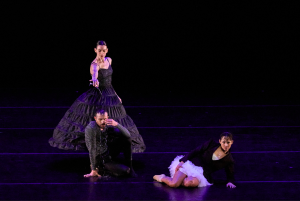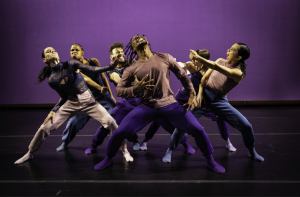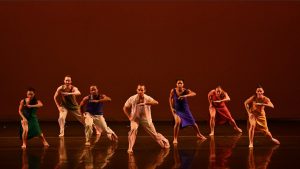
How to describe BodyTraffic? Returning for its fourth appearance as part of the Duncan Theatre’s acclaimed Modern Dance Series, this Los Angeles-based dance company is not your regular kind of anything, as its Feb. 2 performance was really something quite out of the ordinary.
The company, which does not define itself by one style of dance or choreography, communicates with a language distinctly its own. The fact is that BodyTraffic is a cauldron of collaborative artistry with a heavy dose of theatricality and integrity.
Even though there were four pieces by four choreographers presented, there was a discernible cohesion in the program’s artistry. After listening to the post-performance talk-back, it was clear that this comes from the synergy of the artistic direction by Tina Finkleman Berkett and the deep dedication of its performers to the works they dance.
Although it is a decidedly contemporary company, it was interesting to note that several of the works that BodyTraffic presented Feb. 2 reached back to the mid-1900s for inspiration — perhaps to draw attention to parallels with today’s world.
It was the persona of Peggy Lee, one of the most important female singer-songwriters in American jazz, who was the impetus for choreographer Matthew Neenan to create the opening work on the program, A Million Voices (2018). Psychologist Carl Jung believed that persona is the social face one chooses to show to the world (different from one’s personality). Lee was an extremely popular singer during the 1940s and 1950s who had a brazen and sensual voice.
The songs that she sang (and often wrote) encouraged people to embrace the passion of living even in the darkest of times. Pour a chilled martini and put a song on the record player, was her message. Set to a variety of her best-known songs, Neenan successfully caught that mood, serving up the toe-tapping nostalgic charm of the 40’s mixed with delightful whimsical novelty.
With fun and clever movement that had a cartoonish quality, A Million Voices served as a great and sophisticated introduction to the company artists and solidifying them in one’s memory. Highlighted first in solos and duets, the four women and four men of the company appeared in a zany collection of black-and-white clothing that helped personalize each dancer as a different character.
The opening duet was marvelously performed by husband and wife Joan Rodriguez and Katie Garcia to the repeating refrain of “My mama done tol’ me” (Harold Arlen’s “Blues in the Night”). Tiare Keeno, with a little black fascinator hat perched on her head, showed a strength of presence in her solo. Bare-chested and wearing long, bright white shorts, Ty Morrison was a personal and powerful performer. The other company members — Pedro Garcia, Alana Jones, Guzmán Rosado and Jordyn Santiago — supplemented the cast each adding another dimension of depth and enjoyment to Neenan’s choreography.
In the final section of A Million Voices, a delightful frieze of silhouetted dancers entered on the repeated refrains of the lyrics, looking like a traveling vaudeville circus as they traversed the stage dressed in an array of open umbrellas, silly hats, funny skirts and with — of course — cocktail glasses lifted high.
Later, as the content of the martinis were unceremoniously poured on the unsuspecting heads of others (as if it were some the kind of dismal anointment), Lee’s persona of “isn’t life grand?” was literally dampened as her alluring voice rang out with “Then let’s keep dancing. Let’s break out the booze and have a ball. If that’s all there is.” (Lieber and Stoller’s “Is That All There Is?”)
After the smooth familiarity of Lee’s voice and lyrics, we experienced the sound editing and original music of an electro score of James Brown’s iconic voice by composer Shockey, who sampled, deconstructed and looped Brown’s most famous hits so they were still recognizable but reconstituted for a contemporary dramatic effect.

Choreographer Michaela Taylor, a former company dancer, used this urban soundtrack for her work Snap (2019), which (according to the program notes) is an exploration of the loneliness that pervades the search for acceptance in the ethnically diverse yet isolating crowds of LA and the need “to snap out” of it and find a home within yourself.
Right from the get-go, Taylor built conflict in the “duet” of Rodriguez and Keeno, who lip-synced to a loud recorded argument using extreme facial expressions and gestures. Once again, whether dancing on his own or with Rodriguez, it was hard to take your eyes off Morrison. The grimacing, open-mouth motif was repeated throughout the piece as was the male-versus-female energy that precipitated the male trio (danced by Rodriguez, Morrison and Pedro Garcia) which was set to “It’s a Man’s Man’s Man’s World” and sung by Soul Brother No. 1, a.k.a. James Brown.
Without dropping a beat, the dancers adeptly integrated street moves into their vast variety of different dance styles. The ensemble sections in Snap were outstanding with all the dancers moving in absolute unison with the exact same initiation of impulse. The complex movement, choreographed to this novel manipulation of Brown’s music and its deconstructed sounds, had a sense of surprise which made watching it unfold exciting as well as layered.
In the after-performance talk-back, we learned that the work was autobiographical and that the original music with which Taylor had begun choreographing was — surprisingly — music from the popular Christmas ballet, The Nutcracker.
The newest piece on the program was by company dancer and Cuban-born Rodriguez, who choreographed Bloquea’o (2023) to honor the resilience of the Cuban people during the 1962 Cuban Missile Crisis. Using projections of old newsreels to set the scene, Rodriguez wove a rich tapestry of that time to the original music of Pedro Osuna who blended traditional Cuban rhythms, Yoruba chants, historic phone calls and radio broadcasts together with the street sounds of Havana.

Rodriguez, matched again with his wife Garcia, performed an emotionally tense duet with complicated action/reaction moves and risky lifts as they supported and rolled over each other exchanging body weight.
The program ended quietly but delightfully with Pacopepeluto, by Alejandro Cerrudo, who is currently serving as Pacific Northwest Ballet’s first resident choreographer. Cerrudo created this work, which comprises three solos for three men, in 2011 when he was Hubbard Street Dance Company’s first resident choreographer.
In each of the solos, an almost naked body emerged out of the darkness into a warm light that accentuated the highly defined muscles of a male dancer as if he was a Greek sculpture that had come to life. But Cerrudo added a humorous twist by choosing to have these lithesome Dionysian hunks dance in just a G-string to the schmaltzy songs of crooner Dean Martin.
In the first solo, which was choreographed to “Memories are Made of This,” Rodriguez wowed with his amazing dancing only to be one-upped by Morrison in his athletic solo to “In the Chapel in The Moonlight” and Associate Artistic Director Rosado topped off the evening by showing a cheeky side as he hammed it up to “That’s Amore.”
I couldn’t help but admire each of the men’s skillful articulation of the intricate choreography as I smiled and mouthed the lyrics sung by “the king of cool.”